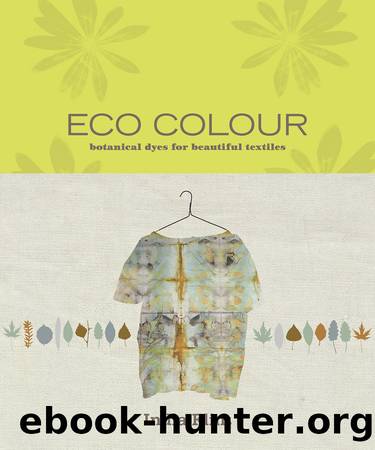Eco Colour by India Flint

Author:India Flint
Language: eng
Format: epub
Publisher: Allen & Unwin
Published: 2021-06-29T00:00:00+00:00
Multiple extractions
Traditionally in most European cultures, plant dyes have been extracted by boiling the plant material in a pot with water, much as though one were making a soup. Most recipes suggest boiling the plant material for an hour or so and straining off the liquid for use. While this is of course effective in making a coloured solution for use, often much of the full colour potential is wasted and discarded without further thought.
Eastern traditions, however, have for centuries made use of multiple extraction processes, whereby the plant material is chopped into small pieces and firmly packed into a pot (choose one with a well-fitting lid). Water is added to a depth of about one-third of the height of the pot, the lid affixed and the pot heated to boiling point for about 20 minutes. The close-fitting lid is vital to retain steam which, being hotter than boiling water, is of great value in the extraction process.
This method can be used to achieve a range of shades from the one batch of plant material or simply to extract the most possible colour. The material is chopped into small pieces, packed into a large pot and water added. The water does not need to cover all of the material but it does need to be deep enough that the pot wonât boil dry. At least a hand width of water is a good depth to aim for. Place a lid on the pot to retain the steam and simmer gently. After 20 minutes, strain the liquid from the vegetable matter and reserve. A fresh quantity of water is then admitted to the pot and the process repeated at least three times. If there is still colour being produced, repeat until the extract becomes too weak to be useful. The extracts can be kept separate or combined to make a larger volume of dye. Keeping them as individual solutions can offer a range of different shades of the same colour and (somewhat surprisingly) with some plants the first and last extract can actually be different colours. Dye plants rich in colour will yield at least three extracts â some traditional Japanese dye plants yield no fewer than seven useful extracts.
While shades can also be produced by either successive introductions of fibre into the dye-bath or successive extractions of fibre from the dye-bath, the multiple extraction method does in general seem to yield the brightest colours. Note however that this method is not advisable for the eucalypts, as they release a substance called kino after excessive boiling, resulting in dark browns as well as a slightly crusty âhandleâ being achieved.
TESTING FOR ACIDS AND ALKALIS
The reactive colorant in litmus paper was traditionally derived from the lichen Rocella tinctoria. To do this, the lichens were coarsely ground with certain varieties of ash, and soaked for weeks in wooden vessels in a mixture of urine, lime and potash or soda. The mixture was stirred regularly. Eventually the mass became red and then blue. It was reputed to have a scent similar to that of violets and indigo.
Download
This site does not store any files on its server. We only index and link to content provided by other sites. Please contact the content providers to delete copyright contents if any and email us, we'll remove relevant links or contents immediately.
On Writing A Memoir of the Craft by Stephen King(4847)
The Doodle Revolution by Sunni Brown(4667)
A Simplified Life by Emily Ley(4079)
Mummy Knew by Lisa James(3620)
Marijuana Grower's Handbook by Ed Rosenthal(3606)
Better Homes and Gardens New Cookbook by Better Homes & Gardens(3509)
Figure Drawing for Artists by Steve Huston(3360)
Paper Parties by Erin Hung(3354)
Draw Your Day by Samantha Dion Baker(3256)
The Genius of Japanese Carpentry by Azby Brown(3209)
Japanese Design by Patricia J. Graham(3097)
The Code Book by Simon Singh(3055)
Dangerous Girls by Haas Abigail(2955)
Lions and Lace by Meagan Mckinney(2911)
The Curated Closet by Anuschka Rees(2896)
How to Make Your Own Soap by Sally Hornsey(2812)
The Checklist Manifesto by Atul Gawande(2760)
The Wardrobe Wakeup by Lois Joy Johnson(2717)
Zero to Make by David Lang(2716)
